The 20 most famous landmarks in Portugal

Portugal, a nation steeped in history and blessed with stunning natural beauty, offers travelers an extraordinary collection of landmarks that tell the story of exploration, conquest, faith, and artistry. From the golden cliffs of the Algarve to the terraced vineyards of the Douro Valley, from fairy-tale palaces in Sintra to volcanic wonders in the Azores, Portugal’s landmarks showcase the incredible diversity of this Atlantic nation. This comprehensive guide explores the 30 Famous Landmarks in Portugal You Need to Visit, each offering unique insights into the country’s rich heritage and natural splendor.
What are the Most Famous Landmarks in Portugal?
Portugal’s most famous landmarks span centuries of history and encompass both human achievements and natural wonders.
The Belém Tower stands as the nation’s most iconic symbol, representing Portugal’s Age of Discovery when Portuguese explorers mapped unknown seas and established global trade routes.
The Jerónimos Monastery, with its intricate Manueline architecture, celebrates these maritime achievements through stone carvings that blend religious imagery with nautical motifs.
Beyond Lisbon, the fairy-tale Pena Palace crowns Sintra’s mountains with its vibrant colors and Romantic architecture, while Porto’s Dom Luís I Bridge spans the Douro River as an engineering marvel of the industrial age.
These landmarks, along with many others, have earned recognition as UNESCO World Heritage Sites, cementing their importance not just to Portugal but to global cultural heritage.
Top Iconic Landmarks in Portugal
The Essential Five
Among Portugal’s countless attractions, five landmarks stand out as absolute must-sees. The Belém Tower (Torre de Belém), built between 1514-1520, serves as Portugal’s most photographed monument.

This UNESCO World Heritage Site combines defensive architecture with decorative Manueline style, featuring intricate stone carvings and Moorish-influenced details.
The Jerónimos Monastery nearby represents the pinnacle of Manueline architecture.
Commissioned by King Manuel I in 1502, it houses the tombs of Vasco da Gama and poet Luís de Camões, connecting visitors directly to Portugal’s golden age of exploration.
Pena Palace in Sintra appears like something from a fairy tale, with its bold red, yellow, and blue sections perched high above the surrounding landscape.
Built in the 19th century by King Ferdinand II, it exemplifies Romantic architecture at its most exuberant.
The Dom Luís I Bridge in Porto, designed by a student of Gustave Eiffel, offers both practical transportation and spectacular views. Its double-deck design has become synonymous with Porto’s skyline.
Finally, Cabo da Roca, the westernmost point of continental Europe, provides dramatic natural beauty where rugged cliffs meet the Atlantic Ocean, marked by a lighthouse dating from 1772.
Famous Monuments and Their History
Portugal’s monuments serve as stone chronicles of the nation’s journey through time.
The São Jorge Castle in Lisbon, with foundations possibly dating to the 1st century BC, has witnessed Roman, Moorish, and Portuguese rule.
Each civilization left its mark on the fortress, creating layers of history visible in its walls and towers.
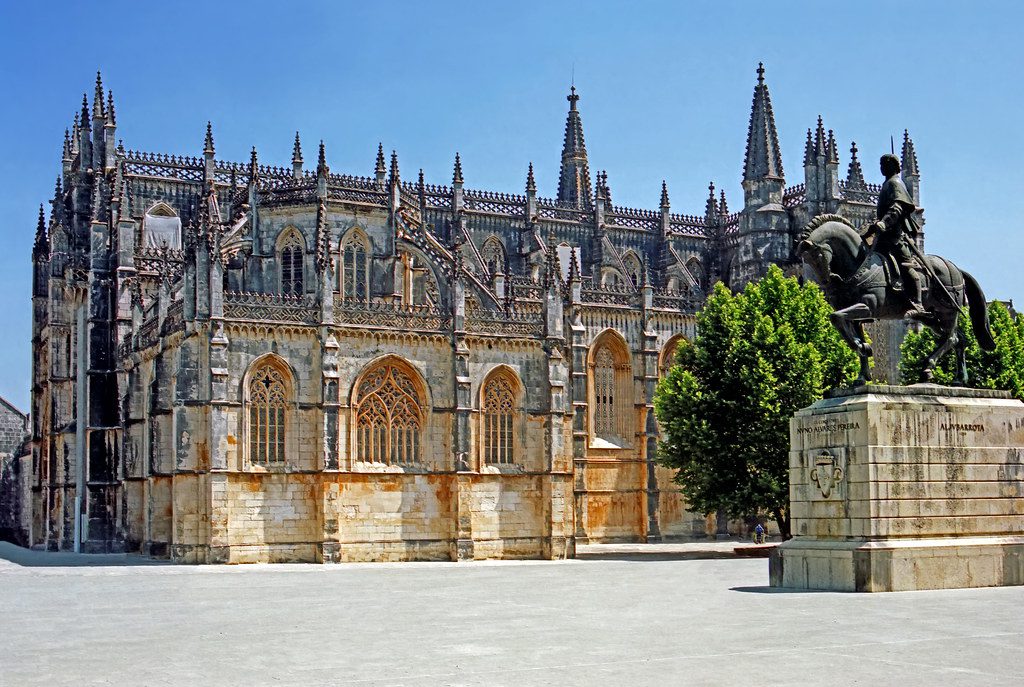
The Batalha Monastery, built to commemorate Portugal’s victory over Castile in 1385 at the Battle of Aljubarrota, represents a turning point in Portuguese independence.
Its Gothic architecture features the famous Unfinished Chapels, left incomplete but hauntingly beautiful in their skeletal stone tracery.
The Alcobaça Monastery, founded in the 12th century, tells Portugal’s most tragic love story through the tombs of Pedro and Inês.
Their tale of forbidden love and political intrigue rivals any Shakespearean drama, with the ornate tombs facing each other so the lovers will see one another when they rise on Judgment Day.
The Convent of Christ in Tomar reveals the mysterious history of the Knights Templar in Portugal.
Originally built as a Templar stronghold in the 12th century, it later became the headquarters of the Order of Christ after the Templars’ dissolution, preserving their architectural and spiritual legacy.
What Makes a Landmark Worth Visiting?
A truly memorable landmark combines several elements: historical significance, architectural beauty, cultural importance, and the ability to transport visitors to another time or perspective.
Portugal’s landmarks excel in all these areas. They offer tangible connections to pivotal moments in world history, from the Age of Discovery to the Reconquista, from Roman times to the modern era.
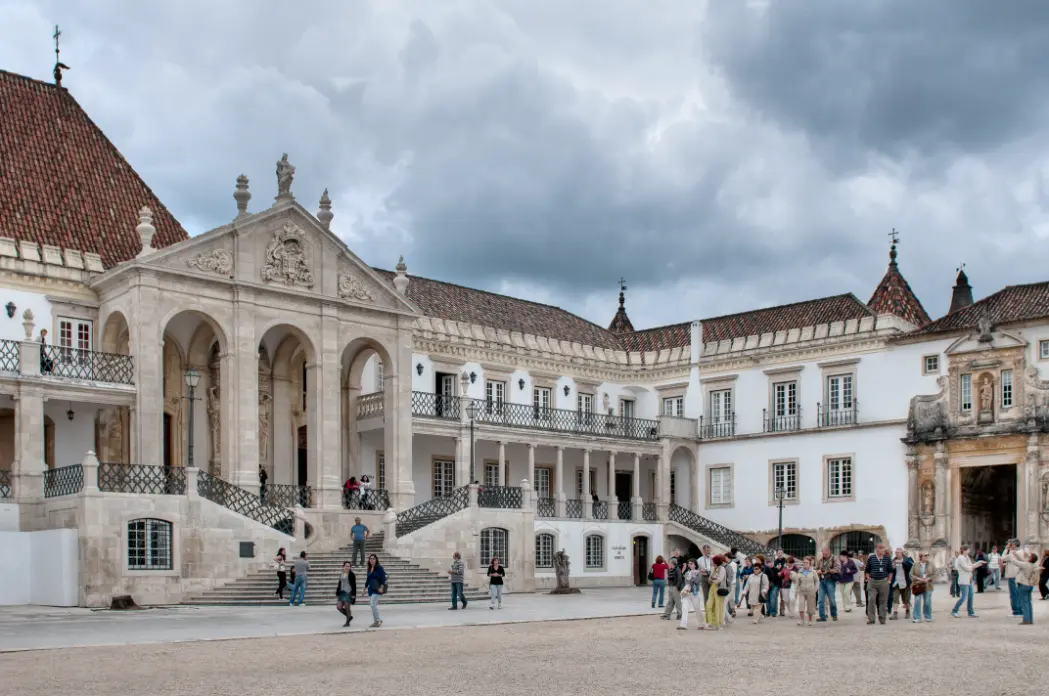
The best landmarks also provide multiple layers of experience. The University of Coimbra, founded in 1290, offers not just beautiful baroque architecture in its Joanina Library but also insights into centuries of Portuguese intellectual tradition.
Similarly, the Douro Valley provides both stunning natural beauty and a living museum of winemaking culture dating back two millennia.
What to Explore in Lisbon: Landmarks in the Capital
Historical Landmarks in Lisbon
Lisbon’s seven hills provide natural pedestals for an array of historical landmarks. The São Jorge Castle crowns the highest hill, offering panoramic views that explain why this location has been fortified since ancient times.
Visitors can walk the ramparts, explore archaeological sites, and encounter the peacocks that roam the grounds.
The Belém district concentrates several major landmarks within walking distance.
Beyond the famous tower and monastery, the area includes the Monument to the Discoveries, celebrating Portugal’s explorers, and the Cultural Center of Belém, bridging historical and contemporary Portuguese culture.
The Alfama district, Lisbon’s oldest neighborhood, survived the 1755 earthquake and preserves the medieval street pattern.
Here, the Sé Cathedral, dating from the 12th century, stands as Lisbon’s oldest church, its fortress-like appearance reflecting the turbulent times of its construction.
Famous Buildings and Monuments in Lisbon
The Santa Justa Lift (Elevador de Santa Justa) represents a different era of Lisbon’s development.
This neo-Gothic elevator, built in 1902, connects the lower Baixa district with the higher Carmo area. Its iron structure and decorative details make it both a practical transportation solution and an architectural landmark.
The 25 de Abril Bridge, reminiscent of San Francisco’s Golden Gate Bridge, spans the Tagus River as one of Europe’s longest suspension bridges.
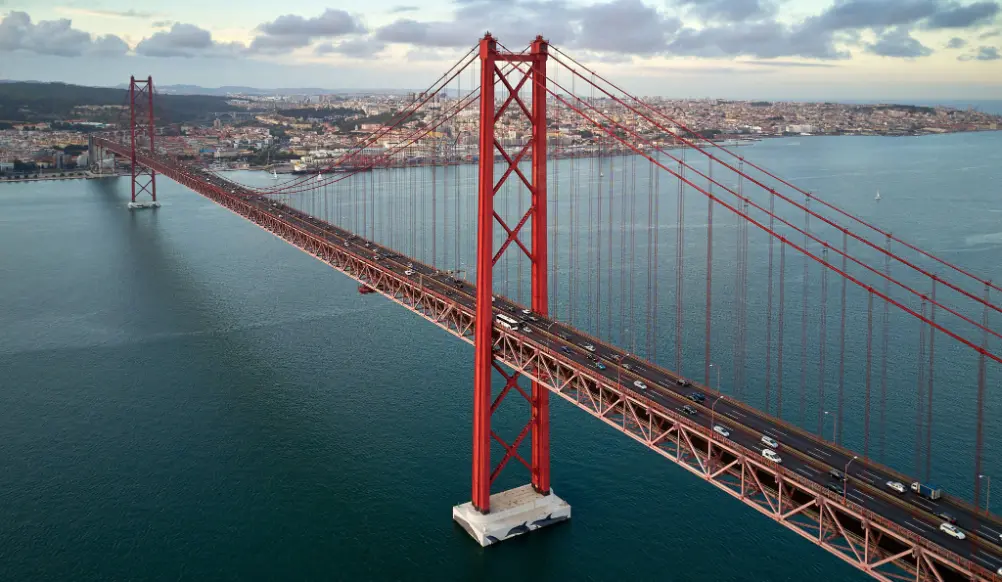
Completed in 1966, it symbolizes Portugal’s modernization while providing spectacular views of the city.
The National Pantheon, housed in the Church of Santa Engrácia, took nearly 300 years to complete, giving rise to the Portuguese expression “like the works of Santa Engrácia” for any lengthy project.
Today it houses the tombs of Portuguese luminaries, including fado singer Amália Rodrigues.
Must-Visit Attractions in Lisbon
Beyond individual monuments, Lisbon offers landmark experiences. The historic Tram 28 route winds through the city’s most picturesque neighborhoods, providing a moving tour of Lisbon’s architectural heritage.
The Time Out Market combines traditional market stalls with contemporary Portuguese cuisine, creating a culinary landmark.
The LX Factory, a former industrial complex turned creative hub, represents Lisbon’s transformation into a modern European capital while preserving its industrial heritage. These contemporary landmarks complement the historical sites, showing Lisbon as a living, evolving city.
Discovering Porto: A City of Landmarks
Iconic Landmarks in Porto
Porto’s Historic Centre, a UNESCO World Heritage Site, encompasses an extraordinary concentration of landmarks. The Sé Cathedral stands as a fortress-church, its Romanesque bulk modified over centuries with Gothic and Baroque additions.
The adjacent Episcopal Palace offers insights into ecclesiastical power in medieval Portugal.
The Church of São Francisco surprises visitors with its modest Gothic exterior that conceals one of Europe’s most spectacular Baroque interiors, with nearly 600 pounds of gold leaf covering carved woodwork depicting vines, angels, and animals.
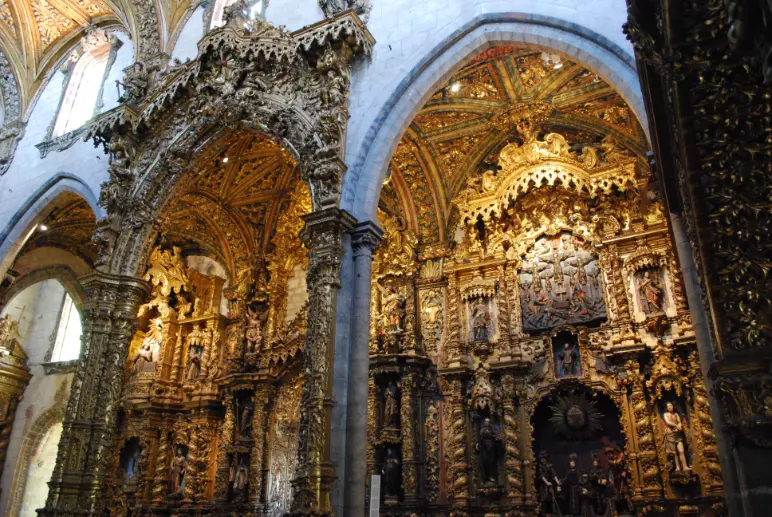
The Palácio da Bolsa (Stock Exchange Palace) showcases 19th-century prosperity with its stunning Arabian Hall, inspired by Granada’s Alhambra and taking 18 years to complete.
This commercial palace represents Porto’s mercantile heritage and continues to host official receptions.
Famous Portuguese Landmarks in Porto
The Torre dos Clérigos provides Porto’s most recognizable vertical landmark. This 75-meter Baroque tower requires climbing 240 steps but rewards visitors with 360-degree views of the city. The adjacent church showcases Italian architect Nicolau Nasoni’s influence on Porto’s Baroque architecture.
The Livraria Lello, often cited as one of the world’s most beautiful bookstores, features a stunning neo-Gothic interior with a remarkable curved staircase. Its architectural beauty has made it a pilgrimage site for book lovers and architecture enthusiasts alike.
The São Bento Railway Station transforms transportation into art with its main hall decorated with 20,000 azulejo tiles depicting Portuguese history and transport evolution. These blue and white tiles, painted by Jorge Colaço, took 11 years to complete.
What to See in Vila Nova de Gaia
Across the Douro River, Vila Nova de Gaia houses the port wine cellars that have made Porto famous worldwide. These wine lodges, many operating for centuries, offer tours explaining port wine production and aging, followed by tastings with river views.

The Monastery of Serra do Pilar, perched above the wine cellars, provides the best panoramic views of Porto. Its unusual circular church and cloister, unique in Portugal, create perfect geometric harmony while offering strategic military advantages that made it important during the Peninsular War.
The Cable Car of Gaia connects the riverfront with the upper areas, providing aerial views of both Porto and Vila Nova de Gaia while serving as a modern landmark complementing the historic bridges.
Natural Landmarks in Portugal: A Different Kind of Beauty
Exploring Natural Landmarks in Portugal
Portugal’s natural landmarks rival its architectural treasures in beauty and significance.
The Douro Valley, a UNESCO World Heritage landscape, showcases humanity’s harmonious relationship with nature through centuries of terraced vineyards carved into steep hillsides.
This living, productive landscape produces both renowned table wines and the famous Port wine.
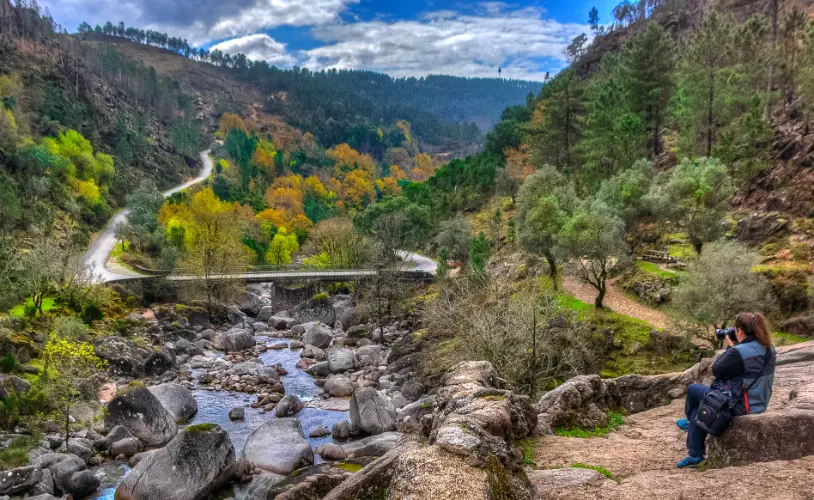
The Peneda-Gerês National Park, Portugal’s only national park, preserves ancient landscapes including Roman roads, medieval castles, and traditional villages alongside diverse ecosystems supporting Iberian wolves, golden eagles, and wild Garrano horses.
The Ria Formosa Natural Park in the Algarve protects a unique coastal lagoon system supporting incredible biodiversity. This barrier island system changes with tides and seasons, creating an ever-shifting landscape of channels, salt marshes, and sandy islands.
Famous Natural Landmarks Worth a Visit
The Benagil Cave (Algar de Benagil) has become one of Portugal’s most photographed natural landmarks.
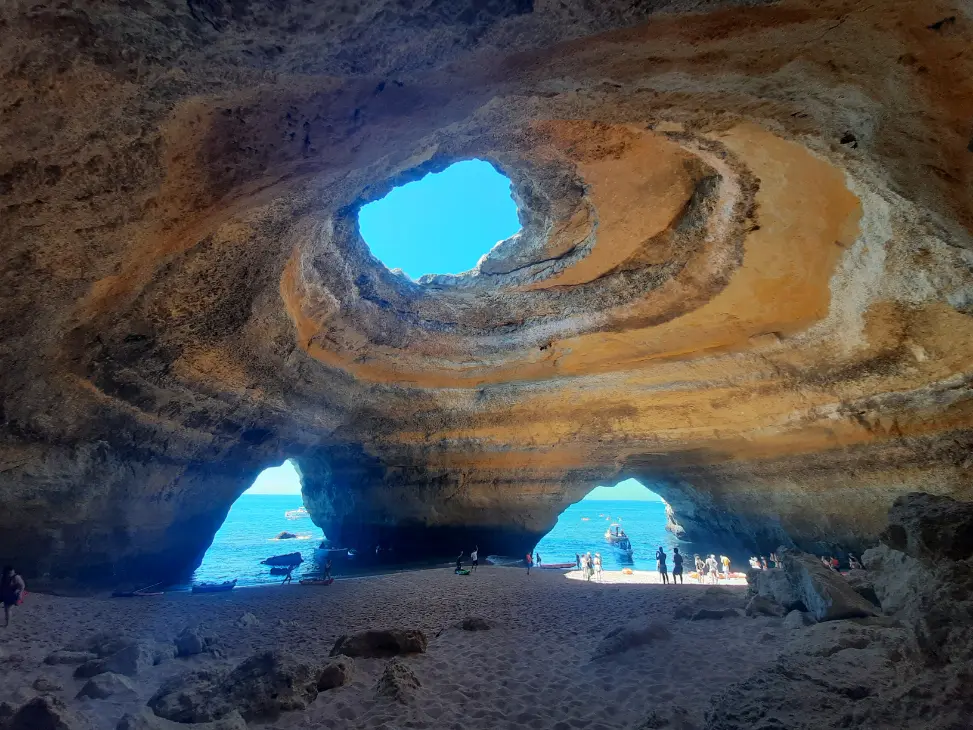
This sea cave features a collapsed roof creating an oculus that illuminates the interior beach with ethereal light. Accessible by boat, kayak, or swimming, it represents the Algarve’s dramatic coastal geology.
Ponta da Piedade near Lagos offers a spectacular display of golden sandstone cliffs, hidden grottos, and natural arches.
The interplay of turquoise water, golden rock, and blue sky creates a painter’s palette of colors, while boat tours navigate through towering sea stacks and hidden caves.
The Seven Hanging Valleys Trail, located between Praia da Marinha and Praia de Vale Centeanes, ranks among Europe’s most beautiful coastal walks. This clifftop path reveals successive viewpoints over pristine beaches, dramatic rock formations, and the endless Atlantic.
Best Natural Attractions in the Algarve
Beyond individual caves and cliffs, the Algarve offers a range of comprehensive natural experiences.
The Costa Vicentina Natural Park preserves Europe’s best-preserved coastal strip, where dramatic cliffs alternate with pristine beaches largely untouched by development.
Praia da Marinha, consistently rated among the world’s most beautiful beaches, exemplifies the Algarve’s natural beauty with its clear waters, golden cliffs, and distinctive rock formations.
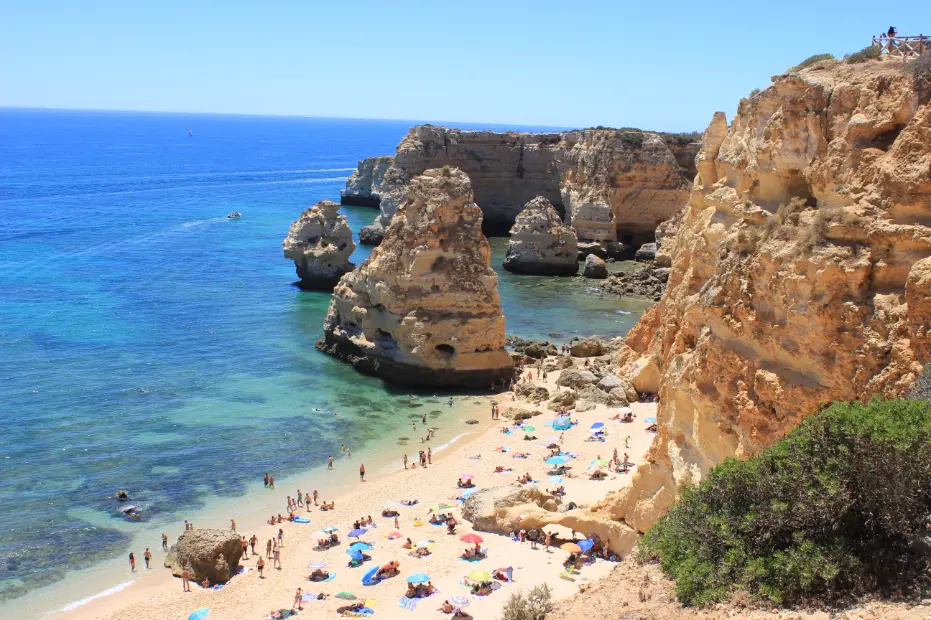
The beach serves as a gateway to underwater caves popular with divers and snorkelers.
The Via Algarviana long-distance trail crosses the region’s mountainous interior, revealing a different Algarve of cork oak forests, traditional villages, and panoramic viewpoints far from the coastal crowds.
Historical and Cultural Significance of Portugal’s Landmarks
UNESCO World Heritage Sites in Portugal
Portugal’s seventeen UNESCO World Heritage Sites reflect the nation’s outsized contribution to world culture.
The Historic Centre of Guimarães, birthplace of Portugal’s first king, preserves medieval urban planning and architecture that influenced Portuguese colonial cities worldwide.
The Historic Centre of Évora showcases 2,000 years of history, from the Roman Temple of Diana to Renaissance palaces, while the macabre Chapel of Bones reminds visitors of mortality through walls decorated with human skulls and bones.
The University of Coimbra – Alta and Sofia represents one of Europe’s oldest universities and its influence on Portuguese-speaking cultures worldwide.
The Joanina Library, with its Baroque grandeur and colony of bats that protect the books from insects, exemplifies the marriage of beauty and function.

The Prehistoric Rock Art Sites in the Côa Valley preserve Europe’s largest open-air Paleolithic art gallery, with engravings dating back 25,000 years.
This site revolutionized the understanding of prehistoric art and required flooding a valley to preserve it.
Famous Historical Landmarks and Their Stories
The Sanctuary of Fátima commemorates the 1917 apparitions of the Virgin Mary to three shepherd children, becoming one of Christianity’s most important pilgrimage sites.
The complex includes two basilicas and the Chapel of the Apparitions, attracting millions of pilgrims annually.
Monsanto, known as Portugal’s “Most Portuguese Village,” integrates human habitation with massive granite boulders.
Houses built around, under, and incorporating these geological giants create a unique landscape where nature and culture merge inseparably. The medieval castle crowning the hilltop offers views extending to Spain.
The Bragança Castle in Portugal’s northeast preserves one of the country’s best medieval citadels. Its unique pentagonal Domus Municipalis represents the only surviving example of Romanesque civil architecture in Portugal.
How Landmarks Reflect Portugal’s Culture
Portugal’s landmarks embody key cultural values: saudade (melancholic longing), maritime courage, religious devotion, and architectural innovation.
The Manueline style, unique to Portugal, transforms stone into rope, coral, and exotic foliage, celebrating maritime discoveries through architectural vocabulary.
The prevalence of azulejo tiles across Portuguese landmarks reflects both Moorish influence and distinctive Portuguese adaptation.

These painted ceramic tiles narrate history, depict religious scenes, and create cooling interior environments, becoming Portugal’s most distinctive decorative art.
The integration of landmarks with landscape, from Sintra’s palace-studded mountains to the Douro’s terraced valleys, shows Portuguese respect for natural settings.
Rather than dominating nature, Portuguese landmarks often enhance and frame natural beauty.
Must-Visit Landmarks in Sintra and Beyond
Exploring the Wonders of Sintra
Sintra’s concentration of palaces, castles, and gardens earned it UNESCO World Heritage status as a Cultural Landscape.
The town’s microclimate, cooler and mistier than the surrounding areas, created a royal retreat that attracted nobility for centuries.

The Sintra National Palace, distinguished by twin conical chimneys, preserves the best medieval royal palace in Portugal.
Each room tells a story, from the Magpie Room commemorating court gossip to the Swan Room celebrating royal marriages.
The Quinta da Regaleira offers an initiatic journey through symbolism-laden gardens. Its Initiation Well, an inverted tower penetrating the earth, provides a mystical experience as visitors descend through nine levels representing Dante’s circles of Hell.
Famous Landmarks in Sintra
The Moorish Castle (Castelo dos Mouros) provides a dramatic counterpoint to Sintra’s romantic palaces. These 8th-century fortifications snake across mountain ridges, offering spectacular views and insights into medieval military architecture.
The Monserrate Palace showcases exotic Romantic architecture blending Gothic, Indian, and Moorish influences. Its botanical gardens feature plants from five continents, creating themed landscapes from Mexican deserts to Japanese gardens.
The Capuchos Convent offers contemplative simplicity, contrasting with Sintra’s palatial grandeur.
This 16th-century Franciscan monastery, with tiny cork-lined cells, embodies monastic humility and harmony with nature.
Trip to Sintra: A Bucket List Destination
A well-planned Sintra visit requires strategic choices given the wealth of attractions. Starting early at Pena Palace avoids crowds and provides morning light for photography. The walk down through Pena Park to the Moorish Castle combines exercise with botanical discovery.
Sintra village offers traditional pastries like travesseiros and queijadas, providing energy for afternoon palace visits. The historic tram to Praia das Maçãs beach offers a scenic journey from the mountain to the ocean.
Evening visits to less-crowded sites like Capuchos Convent or Monserrate Palace provide peaceful experiences and different lighting conditions that transform familiar landmarks.
Island Landmarks: Madeira and the Azores
Madeira’s Dramatic Landscapes
Pico do Areeiro, Madeira’s third-highest peak at 1,818 meters, offers accessible mountain experiences with parking near the summit. Sunrise visits reveal seas of clouds pierced by volcanic peaks, creating otherworldly landscapes.
Pico Ruivo, Madeira’s highest point at 1,861 meters, requires hiking but rewards with 360-degree island views. The trail from Pico do Areeiro, though challenging, ranks among Europe’s most spectacular mountain walks.
The Laurisilva Forest, a UNESCO World Heritage Site, preserves the world’s largest surviving laurel forest. This prehistoric ecosystem, dating back millions of years, supports unique species found nowhere else on Earth.
The Azores’ Volcanic Wonders
Sete Cidades on São Miguel Island showcases nature’s artistry through twin crater lakes of different colors – one appearing blue, the other green. This massive volcanic caldera creates one of the Azores’ most photographed landscapes.
The Furnas Valley combines volcanic activity with human culture through hot springs, fumaroles, and the tradition of cooking cozido stew in underground volcanic heat. The valley’s botanical garden showcases plants from similar climates worldwide.
Pico Mountain on Pico Island, Portugal’s highest peak at 2,351 meters, offers adventurous hikers the chance to summit a volcanic cone with views extending to neighboring islands on clear days.
Planning Your Visit: Best Time to Experience Portugal’s Landmarks
Best Time to Visit Portugal for Landmark Exploration
Spring (March to May) offers ideal conditions for landmark visits with mild temperatures, blooming gardens, and fewer tourists. Sintra’s palaces, surrounded by spring flowers and the Douro Valley’s terraces turning green, create particularly memorable experiences.
Summer (June to September) brings reliable weather but also crowds at popular landmarks. Early morning or late afternoon visits avoid both crowds and harsh midday sun. Coastal landmarks like Benagil Cave and Ponta da Piedade shine in summer’s clear weather.
Autumn (October to November) provides comfortable temperatures and golden light ideal for photography. The Douro Valley’s harvest season adds cultural experiences to the landscape’s beauty.
Winter (December to February) offers crowd-free landmark visits and different perspectives. Misty Sintra palaces and dramatic Atlantic storms at Cabo da Roca create atmospheric experiences unavailable in summer.
How to Plan Your Trip to Visit Famous Landmarks
Strategic geographic planning maximizes landmark visits. Lisbon serves as an ideal base for exploring Belém, Sintra, and Cascais. Porto provides access to the Douro Valley and northern landmarks. The Algarve requires dedicated time for its scattered coastal landmarks.
Portugal’s excellent transportation infrastructure facilitates landmark visits. Trains connect major cities efficiently, while rental cars provide flexibility for rural landmarks. Many landmarks offer combination tickets providing savings and skip-the-line access.
Accommodation choices can enhance landmark experiences. Pousadas, hotels in historic buildings including castles and monasteries, allow overnight stays in landmarks themselves. Rural tourism properties near natural landmarks provide immersive experiences.
Tips for Visiting Popular Landmarks in Portugal
Booking for popular landmarks like Pena Palace, Livraria Lello, and Benagil Cave tours prevents disappointment, especially in peak season. Many sites offer online tickets with time slots to manage visitor flow.
Comfortable walking shoes prove essential as many landmarks require walking on uneven surfaces, climbing stairs, or hiking. Layered clothing adapts to Portugal’s varied microclimates, particularly in mountainous areas.
Photography restrictions vary by landmark. While most welcome photography, some prohibit flash or tripods. Churches and museums may restrict photography entirely. Drone use requires permits at most landmarks.
Learning basic Portuguese phrases enhances interactions at less-touristy landmarks. While English is widely spoken at major sites, rural landmarks may have Portuguese-only information.
Respecting landmark rules preserves these treasures for future generations. This includes staying on marked paths, not touching artwork or azulejos, and following photography guidelines.
Conclusion
Portugal’s 30 famous landmarks offer windows into different eras, cultures, and landscapes that have shaped this remarkable nation.
From the Belém Tower’s maritime symbolism to the Douro Valley’s agricultural heritage, from Pena Palace’s Romantic fantasy to Cabo da Roca’s raw natural power, each landmark contributes to Portugal’s rich tapestry.
These landmarks transcend mere tourist attractions, serving as touchstones of Portuguese identity and world heritage.
They tell stories of exploration and discovery, faith and devotion, human creativity and natural wonder.
Whether you seek historical insights, architectural beauty, or natural spectacles, Portugal’s landmarks provide experiences that linger long after your visit ends.
FAQs: The 30 Most Famous Landmarks in Portugal
What are the most famous landmarks in Portugal?
The most famous landmarks in Portugal include iconic sites such as the Belem Tower in Lisbon, the Pena Palace in Sintra, and the Dom Luís I Bridge in Porto. Each of these landmarks showcases unique architectural styles and offers insights into Portugal’s rich history.
Other notable mentions are the Quinta da Regaleira, the historic center of Lisbon, and various UNESCO World Heritage sites scattered across the country.
Which famous monuments in Portugal should I visit?
When visiting Portugal, you should definitely include famous monuments such as the Jerónimos Monastery in Lisbon, the Castle of the Moors in Sintra, and the Roman Temple of Évora.
These monuments are not only significant historical landmarks but also offer stunning views and a glimpse into Portugal’s past.
What landmarks in Lisbon are a must-see?
Lisbon is home to many famous landmarks, including the iconic Tram 28, the São Jorge Castle, and the vibrant Alfama district.
Visitors should also explore the Praça do Comércio and the beautiful Belém district, where you can find the Jerónimos Monastery and the Belém Tower.
Are there any natural landmarks in Portugal?
Yes, Portugal boasts several beautiful natural landmarks, such as the stunning cliffs of the Algarve, the Douro Valley’s terraced vineyards, and the breathtaking Arrábida Natural Park.
These natural sites are perfect for outdoor enthusiasts and those looking to experience Portugal’s diverse landscapes.
What are some historical landmarks in Portugal?
Portugal is rich in historical landmarks, including the Convent of Christ in Tomar, the ancient city walls of Óbidos, and the historic center of Guimarães, which is often referred to as the birthplace of Portugal.
These sites provide a deeper understanding of Portugal’s history and culture.
What are the best places to visit in central Portugal?
Central Portugal offers a variety of landmarks to visit, including the stunning Batalha Monastery, the picturesque town of Coimbra with its historic university, and the beautiful landscapes of the Serra da Estrela mountains.
Each location provides a unique experience and showcases the region’s charm.
Which famous Portugal landmarks are UNESCO World Heritage sites?
Several famous Portugal landmarks are designated as UNESCO World Heritage sites, including the Tower of Belém, the Monastery of Batalha, and the cultural landscape of the Douro Valley.
These sites highlight the country’s rich cultural heritage and are essential stops for any visitor.
What are some popular attractions in Porto?
In Porto, visitors can explore famous attractions such as the Livraria Lello, often regarded as one of the most beautiful bookstores in the world, the Dom Luís I Bridge, and the historic Ribeira district.
These sites reflect Porto’s vibrant culture and stunning architecture.




